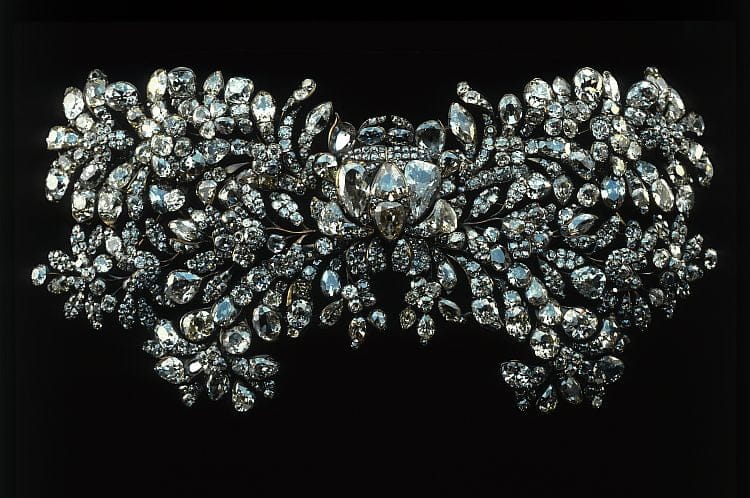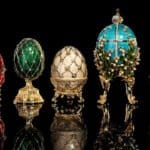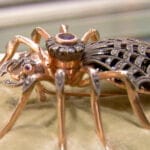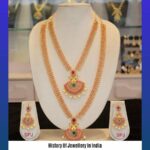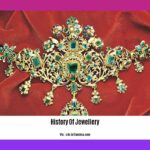Delve into the dazzling world of “Jewels of the Tsars: Fabergé and the Opulence of Imperial Russia.” This exploration unveils the captivating artistry and historical significance of Fabergé jewelry during the Romanov era. Renowned for their exquisite craftsmanship, these pieces epitomized the grandeur of Imperial Russia, reflecting a culture of unparalleled luxury and artistic innovation.
Fabergé Jewelry in Imperial Russia
Step into a realm of shimmering diamonds, vibrant enamel, and breathtaking artistry—the captivating world of Fabergé jewelry in Imperial Russia. While the name Fabergé has become synonymous with luxury and opulence, a deeper dive reveals a fascinating narrative woven with talented artisans, forgotten masterpieces, and an enduring legacy.
In the late 19th and early 20th centuries, the House of Fabergé rose to prominence, becoming the jeweler of choice for the Russian elite, including the Tsars themselves. Yet, this era was also graced by other exceptionally talented jewelers like Khlebnikov, Perkhin, and Rappoport, who crafted pieces that could rival even the most impressive Fabergé creations. These masters of their craft produced a stunning array of jewelry, from diamond-encrusted tiaras and envy-inducing necklaces to intricately designed brooches that resembled miniature works of art. These weren’t mere adornments; they were bold statements of wealth, power, and refined taste.
Many of these masterpieces are now tucked away in private collections or displayed within the hallowed halls of museums. One such example is the “Order of the Golden Fleece” brooch crafted by the skilled hands of Rappoport. This brooch offers a glimpse into Russia’s rich artistic heritage, a testament to the exceptional craftsmanship of a bygone era.
What set these imperial jewelers apart was their ability to transform precious metals and gemstones into miniature works of art. They were masters of techniques like enameling, where vibrant colors were meticulously fused onto metal, and guilloché, a technique that created intricate patterns that danced with light. Their mastery of gemstone setting, where each stone was carefully placed to maximize its brilliance, added another layer of sophistication to their creations.
Beyond technical skill, these jewelers were artists at heart, drawing inspiration from Russian folklore, the beauty of nature, and even historical events. Their designs weren’t merely aesthetically pleasing; they were narratives waiting to be deciphered, whispers of secrets from a bygone era, reflecting the very spirit of Russia itself.
Within the opulent settings of the Imperial court, jewelry served as more than mere adornment. Picture a grand ballroom filled with elegantly dressed nobles, the air alive with conversation and laughter. Now, imagine the mesmerizing shimmer of jewelry, each piece reflecting the candlelight and amplifying the atmosphere of opulence. In this world, jewelry was an emblem of status, a means to showcase wealth and importance. A dazzling tiara could make a powerful statement, a necklace could tell a captivating story, and a brooch could serve as a subtle nod to power and prestige.
Ongoing research continues to unearth more about these lesser-known jewelers, adding layers to our understanding of this fascinating period. Every new discovery is a reminder that the world of imperial Russian jewelry extends beyond Fabergé, encompassing a rich tapestry of talent, artistry, and an enduring legacy.
Who Was The Jeweler To The Romanovs?
Peter Carl Fabergé, a name synonymous with luxury and artistry, became the preeminent jeweler to the Romanovs. In 1885, Tsar Alexander III, seeking a truly exceptional Easter gift for his wife, commissioned Fabergé, already known for his exceptional skill, to craft something extraordinary. This marked the beginning of a legacy that would forever intertwine the House of Fabergé with the Romanov dynasty.
Fabergé’s creation, far from an ordinary Easter egg, captivated the Tsar and his court. This exquisite object, meticulously crafted and imbued with intricate details, transcended mere jewelry to become a work of art. This pivotal moment catapulted Fabergé to fame, ultimately earning him the prestigious title of official goldsmith to the Russian imperial court.
The Fabergé eggs were far from ordinary Easter novelties. These intricate creations often concealed surprises, such as hidden compartments, miniature portraits, and even tiny, functioning clocks. Each egg was a story waiting to be told, often reflecting significant events in the Romanov family or Russian history.
These were not mere trinkets; they represented the immense wealth and power of the Romanovs. Owning a Fabergé egg became a status symbol, a sign of unparalleled luxury and refinement. Imagine the excitement and anticipation as the Tsarina awaited her unique Fabergé egg each year—a tradition that embodied the grandeur of the era.
Fabergé’s artistry extended beyond the royal family. He created a diverse range of stunning objects, from picture frames and cigarette cases to miniature animals and flowers, all crafted with the same meticulous attention to detail and using only the most precious materials. This distinctive style, instantly recognizable and highly sought after, influenced Russian artistry and design for generations to come.
Even today, Fabergé’s creations continue to fascinate and inspire. Museums and collectors worldwide cherish his works, recognizing them not only as aesthetically beautiful objects but also as windows into a vanished world of imperial splendor.
How to identify Fabergé jewelry?
Given the extraordinary value and historical significance of Fabergé jewelry, how can one differentiate an authentic piece from a clever imitation? It’s an exercise in observation, a quest for telltale clues that reveal the authenticity of these treasured objects.
Look for the “Signature”:
Just as a renowned artist signs their paintings, Fabergé pieces often bear a “signature”—the name “Fabergé” rendered in Cyrillic script (ФАБЕРЖЕ). This inscription, a hallmark of authenticity, should be carefully examined, as skilled forgeries might attempt to replicate it.
Check for Hallmarks:
Hallmarks, akin to “passport stamps” on jewelry, provide valuable information about a piece’s origin. These marks often indicate the place and time of manufacture. For instance, a hallmark might reveal that a piece was crafted in St. Petersburg in 1900. The “Kokoshnik” hallmark, resembling a half-circle or triangle, specifically signifies that the piece was crafted in Russia, adding another layer of authentication.
Recognize the “Family Resemblance”:
Fabergé pieces possess a distinctive style, a cohesive aesthetic that runs through their design. After examining several genuine pieces, one begins to discern similarities in design elements and craftsmanship techniques, whether it’s an egg, a brooch, or a picture frame.
Materials Fit for Royalty:
Fabergé employed only the finest materials in their creations. Look for the use of high-quality gold, sparkling gemstones, and a distinctive type of enamel known for its smooth finish and vibrant colors. Examine the details closely—the craftsmanship should be exquisite, often featuring intricate patterns etched into the metal (a technique known as guilloché).
Trace Its History:
Establishing the provenance, or ownership history, of a piece can be crucial in verifying its authenticity. Auction houses and antique dealers specializing in Fabergé often possess records that can trace a piece back through its previous owners, adding weight to its authenticity.
A Word of Caution:
The market for Fabergé jewelry is rife with forgeries, some more convincing than others. Diligently researching Fabergé’s work and consulting with reputable appraisers can help avoid costly mistakes. Expert authentication is crucial, as a trained eye can discern subtle details that distinguish an authentic piece from a clever fake.
Why did the Fabergé family leave Russia?
The Fabergé family’s decision to flee Russia in the aftermath of the 1917 Revolution was born of necessity, a heartbreaking choice driven by the collapse of their world. The Bolsheviks’ rise to power brought about a seismic shift, transforming the social and political landscape of Russia.
Central to the Bolsheviks’ ideology was the concept of shared ownership, which meant that private property, including the esteemed Fabergé workshops, was subject to nationalization. Imagine pouring your heart and soul into a business, only to have it seized and placed under state control. This is precisely what the Fabergé family endured, forcing them to relinquish their legacy, their livelihood, and ultimately, their homeland.
Beyond the seizure of their business, the political climate in Russia had become increasingly perilous. Carl Fabergé, the family patriarch, was detained and interrogated by the Bolsheviks. Although he was eventually released, this experience starkly illuminated the dangers of remaining in Russia. Fearing for their safety and the well-being of their loved ones, the Fabergé family made the difficult choice to leave behind their lives and seek refuge elsewhere.
Adding to their woes, the Russian economy was in a state of collapse. The nationalization of their assets, compounded by the broader economic downturn, meant that rebuilding their lives and business in Russia would be an insurmountable task. The Fabergé family, once at the zenith of Russian society, became refugees, forced to start anew in a foreign land. Their story serves as a poignant reminder of the profound human cost of revolution.
Is Fabergé still Russian?
The question of whether Fabergé remains Russian is complex, echoing through history with the brilliance of jewels and the tumult of revolution. The name itself evokes the opulence and elegance of Imperial Russia, forever linked to the exquisite creations, especially the legendary Imperial Easter eggs, that continue to captivate imaginations. However, the upheaval of the Russian Revolution irrevocably altered the course of the House of Fabergé.
Established in 1842 by Gustav Fabergé, the House of Fabergé ascended to become the preeminent jeweler, largely due to the patronage of the Russian imperial family. Their workshops, once abuzz with activity, produced masterpieces from gold, silver, and gemstones, each piece a testament to the Tsar’s wealth and power. The 1918 Bolshevik Revolution, however, forced the Fabergé family to flee Russia, leaving behind their workshops, their treasures, and their entire world.
In the aftermath of the revolution, Fabergé creations were scattered across the globe. Some pieces found their way into the hands of private collectors, while others were sold, disappearing into the tides of history. Armand Hammer, an American oil tycoon, acquired a significant portion of the famed Imperial Easter eggs, later donating them to museums. Occasionally, a hidden Fabergé piece resurfaces, each rediscovery adding another layer to the mystery of their journey through time.
Despite the family’s exile, the Fabergé name and brand endured. Over the years, Fabergé trademarks and rights were bought and sold, changing hands like prized gems themselves. Today, Fabergé Limited, a Swiss-based luxury company, owns the name, striving to uphold the tradition of excellence and craftsmanship through new lines of jewelry, watches, and other luxurious creations.
Recognizing the importance of preserving history, museums and private collectors worldwide proudly display their Fabergé treasures. The Kremlin Museum in Moscow houses a significant collection, offering visitors a glimpse into the grandeur that once graced its halls. From the Victoria and Albert Museum in London to the Metropolitan Museum of Art in New York City, these pieces offer a tangible link to the lavish world of Imperial Russia.
Fabergé’s legacy extends beyond museum displays and private collections. Even today, contemporary jewelry makers and designers draw inspiration from the intricate details and techniques pioneered by those masters. Enameling, guilloché—these techniques are now woven into the fabric of fine jewelry, a testament to the enduring influence of the House of Fabergé.
So, is Fabergé still Russian? It’s a question with nuanced layers, much like one of their intricate creations. While the family, workshops, and physical presence are gone from Russia, their artistic soul, the echoes of a bygone era, remains forever intertwined with the nation’s history. In the hands of today’s artists and craftsmen, the legacy of Fabergé continues to evolve, forever bound to its past yet reaching for new horizons.
Did you know that in 2004 lost Faberge masterpieces turned up in a war-torn city? And that one of the artifacts that was not only turned up but sold was the Faberge spider brooch? Read more about it here.
Did any of the Romanov jewels survive?
Remarkably, 57 of the 69 Fabergé eggs created for the Romanov family have survived, enduring revolutions and the passage of time. These intricate eggs provide a captivating glimpse into the House of Fabergé’s remarkable artistry and the Romanovs’ penchant for exquisite objects.
The fate of the Romanovs’ vast jewelry collection is a tale of loss, survival, and enduring mystery. Amidst the turmoil of the 1917 Revolution, some jewels vanished, likely lost forever in the chaos. Others were hastily concealed, hidden so effectively that their rediscovery took decades. The search for these missing treasures continues, fueled by the hope of uncovering them in some forgotten corner of the world.
Despite the tragic demise of the Romanov dynasty, some of their most impressive jewels survived. The awe-inspiring Imperial Crown of Russia, a symbol of power for centuries, stands as a testament to the grandeur of their reign. The ‘Russian Beauty’ Diadem, adorned with shimmering pearls and diamonds, is believed to have belonged to Empress Alexandra Feodorovna, while Maria Feodorovna’s Kokoshnik Diadem showcases the exceptional skill of Romanov jewelers. These surviving pieces are not merely beautiful objects but tangible links to the opulence and tragic history of the Romanov dynasty.
What happened to the Romanov jewels sewn into clothes?
As the Bolshevik Revolution threatened to engulf their world, the Romanovs resorted to desperate measures to safeguard their treasures. Knowing they couldn’t simply pack their valuables, they began secretly stitching precious jewels into their clothing and concealing them within their personal belongings. It was a risky gambit driven by the instinct to preserve what they could for a future in exile.
One particularly daring account involves Grand Duchess Maria Pavlovna, who, with the assistance of a trusted confidant, Professor Bergholz, managed to smuggle a significant portion of her jewels right out from under the noses of their captors. Princess Irina orchestrated a similar escape, working with a British diplomat to successfully move a large collection of jewels from Kislovodsk. These daring acts, carried out during a period of immense uncertainty, highlight the family’s determination to protect their heritage.
The fate of the jewels that didn’t escape with the fleeing Romanovs took a different turn. The newly established Bolshevik government saw the confiscated Romanov treasures as a potential source of revenue to further their political ambitions. However, selling these highly controversial jewels proved more challenging than anticipated. International pressure and a distinct lack of willing buyers forced them to reconsider their approach.
Despite the obstacles, the Bolsheviks managed to sell portions of the collection through clandestine channels. Francis Meynell, a prominent figure in British media as the director of the Daily Herald, played an unexpected role, receiving and ultimately transporting Romanov pearls and diamonds to Britain, a testament to the intricate web of intrigue surrounding these precious artifacts.
To this day, the complete story of the Romanov jewels remains shrouded in mystery. Rumors persist of hidden caches and lost treasures waiting to be rediscovered. While the full extent of what transpired may never be known, the saga of the Romanov jewels, with its tales of daring escapes and international intrigue, continues to captivate and inspire. It stands as a testament to the resilience of a family fighting for survival and clinging to the remnants of their former glory.
- Unveiling Bernhard Caesar Einstein’s Scientific Achievements: A Legacy in Engineering - July 15, 2025
- Uncover who is Jerry McSorley: CEO, Family Man, Business Success Story - July 15, 2025
- Discover Bernhard Caesar Einstein’s Scientific Contributions: Unveiling a Legacy Beyond Einstein - July 15, 2025
